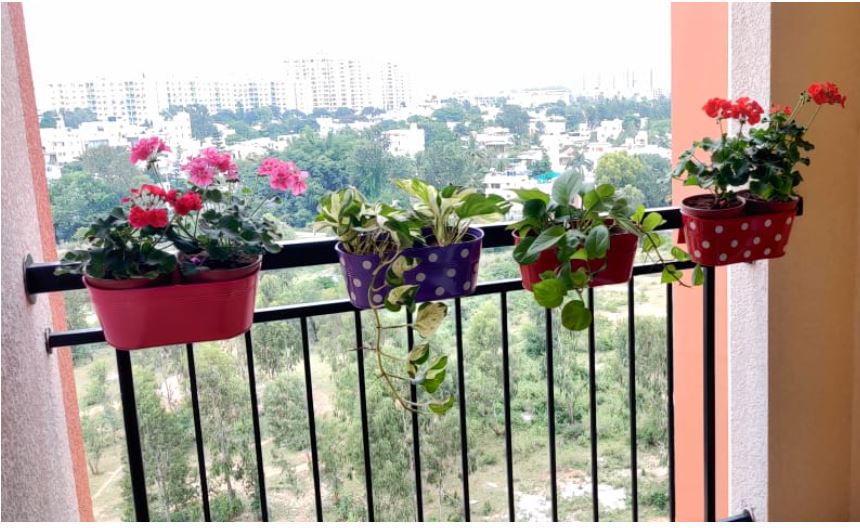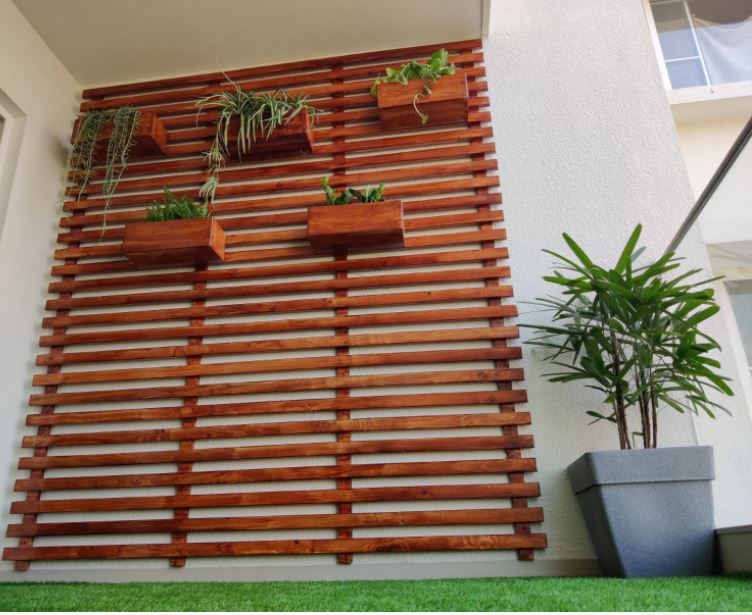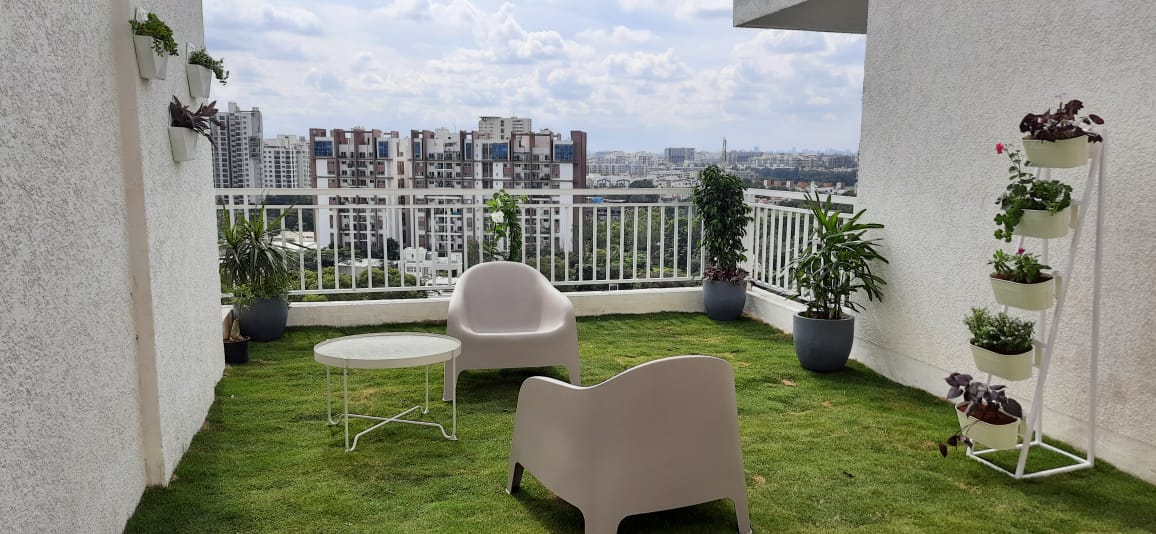Interior plantscaping, also known as interior landscaping, involves the strategic placement and design of plants within indoor spaces to enhance aesthetics, improve air quality, and create a calming environment. It combines elements of horticulture, design, and architecture to integrate plants into interior spaces in a way that complements the overall design and function of the area.
Steps to Set Up a Balcony Garden:
Assess Your Space:
- Size and Layout: Measure your balcony to understand how much space you have and consider the layout. Note any structural elements like railings or walls that could support hanging plants or vertical gardens.
- Weight Limits: Check the load-bearing capacity of your balcony, especially if you plan to use large planters or raised beds.
- Light Conditions: Observe how much sunlight your balcony receives during the day. South-facing balconies usually get full sun, while north-facing ones might have more shade. This will determine which plants will thrive.
Choose the Right Plants:
- Sunlight:
- Full Sun (6+ hours of direct sunlight): Tomatoes, peppers, basil, and sun-loving flowers like marigolds and petunias.
- Partial Sun (3-6 hours of direct sunlight): Leafy greens like lettuce, spinach, and herbs like parsley and chives.
- Shade (Less than 3 hours of direct sunlight): Ferns, ivy, and shade-tolerant flowers like impatiens and begonias.
- Climate Considerations: Select plants suited to your local climate, considering factors like temperature extremes, wind exposure, and humidity.
Container Selection:
- Size and Material: Choose containers that match the size of your plants and your space. Options include terracotta, ceramic, plastic, or metal pots. Consider using lightweight materials to avoid overloading your balcony.
- Drainage: Ensure all containers have drainage holes to prevent waterlogging, which can harm plant roots.
- Self-Watering Planters: These are especially useful for balconies, as they help maintain consistent moisture levels with less frequent watering.
Soil and Fertilization:
- Potting Mix: Use high-quality potting mix rather than garden soil, as it's lighter and drains better. You can also find specialized mixes for specific plants, like cacti or vegetables.
- Fertilization: Container plants need regular feeding since nutrients in the soil can deplete quickly. Use a balanced, slow-release fertilizer or liquid feed every few weeks, depending on the plants' needs.
Irrigation and Watering:
- Manual Watering: Water regularly, especially in hot weather. Morning watering is ideal, as it allows plants to absorb moisture before the sun gets too intense.
- Irrigation Systems: Consider a drip irrigation system or self-watering containers for convenience, particularly if you have a large balcony garden.
- Water Conservation: Mulch the soil surface with organic material like bark or straw to reduce evaporation and retain moisture.
Maximizing Space:
- Vertical Gardening: Use trellises, hanging baskets, or wall-mounted planters to make the most of vertical space. This is perfect for vining plants like beans, cucumbers, or ornamental plants like ivy.
- Tiered Planters: Stackable or tiered planters allow you to grow more plants in a compact area.
- Railings and Balustrades: Utilize railing planters to grow flowers, herbs, or trailing plants that can cascade down.
Decor and Design:
- Seating and Furniture: Incorporate comfortable seating or a small table to create a cozy outdoor space. Foldable furniture is ideal for small balconies.
- Lighting: Add string lights, lanterns, or solar-powered lights to create a warm ambiance for evening enjoyment.
- Decorative Elements: Enhance your balcony garden with decorative elements like wind chimes, small sculptures, or outdoor rugs that complement your plant selection.
Maintenance:
- Pruning and Deadheading: Regularly prune plants to encourage growth and remove dead or spent flowers to keep your garden looking tidy.
- Pest Control: Monitor for pests like aphids, spider mites, or slugs. Use natural remedies like neem oil, insecticidal soap, or introduce beneficial insects.
- Seasonal Changes: Adjust your garden with the seasons by rotating plants, protecting them from frost, or replacing annuals with fresh varieties.
Popular Plants for Balcony Gardens:
- Herbs: Basil, rosemary, thyme, mint, and cilantro.
- Vegetables: Cherry tomatoes, peppers, lettuce, radishes, and spinach.
- Flowers: Petunias, geraniums, marigolds, pansies, and nasturtiums.
- Vines: Sweet peas, morning glories, and climbing roses.
- Ornamental Grasses: Fountain grass, blue fescue, or carex.
Benefits of a Balcony Garden:
- Access to Fresh Produce: Grow your own herbs, vegetables, and fruits.
- Enhanced Aesthetics: Beautify your living space with greenery and flowers.
- Improved Air Quality: Plants can help purify the air by removing toxins and producing oxygen.
- Mental Well-being: Gardening is known to reduce stress and improve mood, offering a peaceful retreat in your home.
Assess Your Space:
- Size and Layout: Measure your balcony to understand how much space you have and consider the layout. Note any structural elements like railings or walls that could support hanging plants or vertical gardens.
- Weight Limits: Check the load-bearing capacity of your balcony, especially if you plan to use large planters or raised beds.
- Light Conditions: Observe how much sunlight your balcony receives during the day. South-facing balconies usually get full sun, while north-facing ones might have more shade. This will determine which plants will thrive.
Choose the Right Plants:
- Sunlight:
- Full Sun (6+ hours of direct sunlight): Tomatoes, peppers, basil, and sun-loving flowers like marigolds and petunias.
- Partial Sun (3-6 hours of direct sunlight): Leafy greens like lettuce, spinach, and herbs like parsley and chives.
- Shade (Less than 3 hours of direct sunlight): Ferns, ivy, and shade-tolerant flowers like impatiens and begonias.
- Climate Considerations: Select plants suited to your local climate, considering factors like temperature extremes, wind exposure, and humidity.
Container Selection:
- Size and Material: Choose containers that match the size of your plants and your space. Options include terracotta, ceramic, plastic, or metal pots. Consider using lightweight materials to avoid overloading your balcony.
- Drainage: Ensure all containers have drainage holes to prevent waterlogging, which can harm plant roots.
- Self-Watering Planters: These are especially useful for balconies, as they help maintain consistent moisture levels with less frequent watering.
Soil and Fertilization:
- Potting Mix: Use high-quality potting mix rather than garden soil, as it's lighter and drains better. You can also find specialized mixes for specific plants, like cacti or vegetables.
- Fertilization: Container plants need regular feeding since nutrients in the soil can deplete quickly. Use a balanced, slow-release fertilizer or liquid feed every few weeks, depending on the plants' needs.
Irrigation and Watering:
- Manual Watering: Water regularly, especially in hot weather. Morning watering is ideal, as it allows plants to absorb moisture before the sun gets too intense.
- Irrigation Systems: Consider a drip irrigation system or self-watering containers for convenience, particularly if you have a large balcony garden.
- Water Conservation: Mulch the soil surface with organic material like bark or straw to reduce evaporation and retain moisture.
Maximizing Space:
- Vertical Gardening: Use trellises, hanging baskets, or wall-mounted planters to make the most of vertical space. This is perfect for vining plants like beans, cucumbers, or ornamental plants like ivy.
- Tiered Planters: Stackable or tiered planters allow you to grow more plants in a compact area.
- Railings and Balustrades: Utilize railing planters to grow flowers, herbs, or trailing plants that can cascade down.
Decor and Design:
- Seating and Furniture: Incorporate comfortable seating or a small table to create a cozy outdoor space. Foldable furniture is ideal for small balconies.
- Lighting: Add string lights, lanterns, or solar-powered lights to create a warm ambiance for evening enjoyment.
- Decorative Elements: Enhance your balcony garden with decorative elements like wind chimes, small sculptures, or outdoor rugs that complement your plant selection.
Maintenance:
- Pruning and Deadheading: Regularly prune plants to encourage growth and remove dead or spent flowers to keep your garden looking tidy.
- Pest Control: Monitor for pests like aphids, spider mites, or slugs. Use natural remedies like neem oil, insecticidal soap, or introduce beneficial insects.
- Seasonal Changes: Adjust your garden with the seasons by rotating plants, protecting them from frost, or replacing annuals with fresh varieties.




